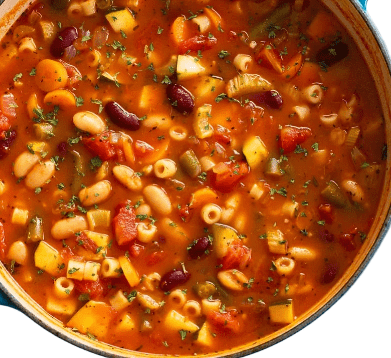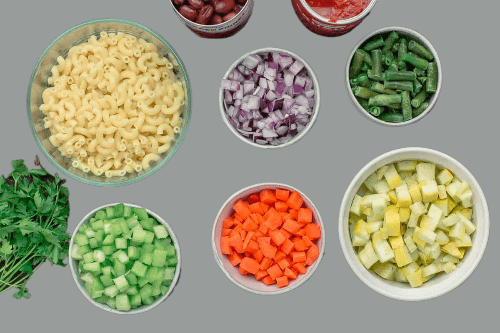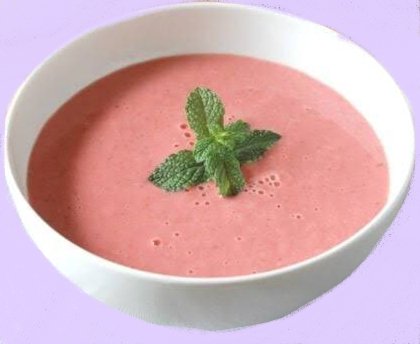Minestrone Soup
Introduction to Minestrone Soup :
Minestrone Soup is a hearty Italian soup that has been enjoyed for centuries. It’s characterized by a rich, tomato-based broth filled with a medley of vegetables, beans, and pasta or rice. What sets Minestrone apart is its versatility—you can use whatever vegetables are in season or available, making each bowl unique and reflective of the moment. It’s a perfect one-pot meal that’s both nourishing and satisfying.

The History of Minestrone Soup :
The word “minestrone” comes from the Italian word “minestra,” meaning soup, and has its roots in the rustic kitchens of ancient Rome. Originally, Minestrone was a humble, peasant dish, born out of necessity to make the most of garden vegetables and leftovers. Over time, it evolved to include new ingredients like beans and pasta as they became staples in the Italian diet. Today, Minestrone Soup is celebrated worldwide for its flexibility, comfort, and rich flavors.
Ingredients and Their Benefits :
- Olive Oil: A key ingredient in Italian cooking, olive oil is heart-healthy, rich in antioxidants, and adds depth to the soup.
- Onion, Garlic, and Celery: The holy trinity of flavor in many soups, these ingredients create the aromatic base of Minestrone.
- Carrots and Zucchini: Packed with vitamins A and C, these vegetables add sweetness and color.
- Tomatoes: New or canned, tomatoes give a wealthy, tart base that’s full of cancer prevention agents like lycopene.
- Beans (Cannellini, Kidney, or Chickpeas): Beans are a source of plant-based protein, fiber, and fundamental minerals.
- Pasta or Rice: Adds body to the soup, making it a complete meal.
- Spinach or Kale: Adds a nutrient boost and vibrant color to the soup.
- Herbs (Basil, Oregano, Thyme): Dried or fresh, herbs infuse the soup with authentic Italian flavors.
- Parmesan Rind: A secret ingredient that adds umami and a rich depth to the broth.

Step-by-Step Recipe :
Preparing the Vegetables :
- Chop the Vegetables: Dice 1 onion, 2 carrots, 2 celery stalks, and 3 cloves of garlic. Slice 1 zucchini and prepare 1 cup of chopped spinach or kale.
- Rinse and Drain Beans: Use 1 can of cannellini beans or kidney beans. Rinse and drain them well.
- Prepare the Tomatoes: If using fresh tomatoes, chop 3-4 large ones. If using canned, one 14-ounce can of diced tomatoes works perfectly.
Cooking the Soup :
- Sauté the Aromatics: In a large pot, heat 2 tablespoons of olive oil over medium heat. Include the diced onion, carrots, celery, and garlic. Sauté for 5-7 minutes until the vegetables are delicate and fragrant.
- Add Tomatoes and Herbs: Add the chopped tomatoes, 1 teaspoon of dried oregano, 1 teaspoon of dried basil, and a sprig of fresh thyme. Stir well and cook for another 5 minutes.
- Pour in the Broth: Add 6 cups of vegetable or chicken broth. For extra flavor, add a Parmesan rind to the pot.
- Simmer: Bring the soup to a boil, then reduce the heat and let it simmer for 20 minutes, allowing the flavors to meld together.
Adding Pasta or Rice :
- Choose Your Grain: For pasta, use small varieties like ditalini, elbow, or orzo. For rice, Arborio or any short-grain rice works well.
- Add Pasta/Rice to the Soup: Stir in 1 cup of pasta or ½ cup of rice. Simmer until the pasta or rice is cooked to your desired tenderness (about 8-10 minutes for pasta, 15-18 minutes for rice).
- Add the Beans and Greens: Stir in the rinsed beans and the chopped spinach or kale. Cook for an extra 5 minutes until the greens are shriveled and delicate.
- Season and Serve: Remove the Parmesan rind, taste, and adjust the seasoning with salt and pepper. Serve hot, garnished with freshly grated Parmesan cheese and a drizzle of olive oil.
Tips for Making the Best Minestrone Soup :
- Build Layers of Flavor: Sautéing vegetables properly before adding liquids helps develop a rich flavor base.
- Use Seasonal Vegetables: Minestrone is all about flexibility. Swap zucchini for butternut squash in the fall or add green beans in the summer.
- Don’t Skip the Parmesan Rind: This little secret ingredient adds depth to the soup. If you don’t have one, a splash of soy sauce or miso can mimic the umami effect.
- Cook Pasta Separately if Storing: To avoid mushy pasta, cook it separately and add to individual servings if you plan on storing leftovers.
Variations of Minestrone Soup :
- Classic Minestrone: Stick to traditional vegetables like carrots, celery, and beans, keeping it simple yet flavorful.
- Winter Minestrone: Add winter vegetables like sweet potatoes, kale, and cabbage for a warming, hearty version.
- Summer Minestrone: Incorporate zucchini, green beans, and fresh basil with a lighter broth for a refreshing summer soup.
- Vegan Minestrone: Skip the Parmesan and use vegetable broth, adding nutritional yeast for an extra umami punch.
- Protein-Packed Minestrone: Add Italian sausage or chicken for a meatier, protein-rich soup.
Serving Suggestions :
- Crusty Bread: Serve Minestrone with slices of warm, crusty Italian bread or garlic bread to soak up the delicious broth.
- Parmesan Topping: A sprinkle of freshly grated Parmesan cheese adds a rich, nutty flavor.
- Side Salad: Pair with a simple green salad dressed with balsamic vinaigrette for a balanced meal.
- Wine Pairing: Enjoy Minestrone with a light red wine like Chianti or a crisp white like Pinot Grigio.
Health Benefits of Minestrone Soup :
Minestrone Soup is not only delicious but also packed with health benefits. It’s high in fiber, vitamins, and antioxidants from the array of vegetables, and the beans provide plant-based protein and iron. The olive oil adds healthy fats, and the overall low-calorie content makes it a great option for weight management. This soup supports heart health, aids digestion, and helps keep you feeling full and satisfied.
Frequently Asked Questions :
Q1: Can I make Minestrone Soup in advance?
A1: Yes! Minestrone Soup tastes even better the next day as the flavors have more time to meld.
Q2: How do I store Minestrone Soup?
A2: Store in an airtight container in the refrigerator for up to 4 days. Reheat on the stove over low heat.
Q3: Can I freeze Minestrone Soup?
A3: Yes, but it’s best to freeze without pasta or rice, as these can become mushy upon thawing. Add freshly cooked pasta or rice when reheating.
Q4: What can I use instead of Parmesan ?
A4: Nutritional yeast or vegan Parmesan are great alternatives that still provide a cheesy, umami flavor.
Conclusion :
Minestrone Soup is a timeless dish that beautifully embodies the spirit of Italian cooking—simple, seasonal, and bursting with flavor. With endless variations and the ability to cater to different dietary needs, it’s the perfect meal for any occasion. Whether you’re cooking for your family or making a pot for the week, Minestrone Soup is sure to warm your heart and soul. Give it a try, experiment with different vegetables, and make it your own!



